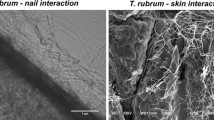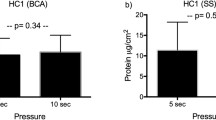Summary
Candida albicans produces a major extracellular proteinase whose activities are observed only in weakly acidic pH. However, in affected lesions, a variety of pH conditions exist, including neutral pH. To verify the pathological importance of the extracellular proteinase, the correlation between culture medium pH, extracellular proteinase activity, and cell growth of C. albicans was followed for 3 weeks with unbuffered and insoluble stratum corneum-supplemented liquid media.
Each medium pH, initially adjusted within a range of pH 3–7 by the addition of sodium hydroxide or hydrochloric acid solution, was acidified, and a subsequent high proteolytic activity and rapid fungal growth were observed. After full fungal growth, neutralization of each medium to pH 7 and reduction of proteinase activity occurred. Results from a glucose addition experiment suggest that acidification of each medium was produced by the acid formation from glucose and neutralization by the exhaustion of glucose and increase of ammonia from denatured stratum corneum. These data suggest that extracellular proteinase from C. albicans could act as a virulence factor under a wide range of pH conditions by the acidification of the environmental pH close to the organism.
Similar content being viewed by others
References
Blank IH (1939) Measurement of pH of the skin surface. II pH of the exposed surfaces of adults with no apparent skin lesions. J Invest Dermatol 2:75–79
Germaine GR, Tellefson LM, Johnson GL (1978) Proteolytic activity of Candida albicans: action on human salivary proteins. Infect Immun 22:861–866
Germaine GR, Tellefson LM (1981) Effect of pH and human saliva on protease production by Candida albicans. Infect Immun 31:323–326
Hattori M, Yoshiura K, Negi M, Ogawa H (1984) Keratinolytic proteinase produced by Candida albicans. Sabouraudia 22:175–183
Johnson SAM (1954) Candida (Monilia) albicans: effect of amino acids, glucose, pH, chlortetracycline (aureomycin), dibasic sodium and calcium phosphates, and aerobic conditions on its growth. Arch Dermatol Syphil 70:49–60
Lang WR, Rakoff AE, Menduke H (1956) Midvaginal pH: is there a significant difference in pH in trichomonal and candidal infections in pregnant and nonpregnant women? Obst Gynecol 7:378–381
Lowry OH, Rosebrough NJ, Farr AL, Randall RJ (1951) Protein measurement with the Folin phenol reagent. J Biol Chem 193:263–275
Negi M, Tsuboi R, Matsui T, Ogawa H (1984) Isolation and characterization of proteinase from Candida albicans. J Invest Dermatol 83:32–36
Olsen I, Birkeland JM (1977) Denture stomatitis-yeast occurrence and the pH of saliva and denture plaque. Scand J Dent Res 85:130–134
Peck SM, Rosenfeld H (1938) The effects of hydrogen ion concentration, fatty acids and vitamin C on the growth of fungi. J Invest Dermatol 1:237–265
Ruchel R, Uhlemann K, Boning B (1983) Secretion of acid proteinases by different species of the genus Candida. Zentralbl Bakteriol Hyg I Orig A 255:537–548
Samaranayake LP, Geddes DAM, Weetman DA, MacFarlane TW (1983) Growth and acid production of Candida albicans in carbohydrate supplemented media. Microbios 37:105–115
Samaranayake LP, Hughes A, MacFarlane TW (1984) The proteolytic potential of Candida albicans in human saliva supplemented with glucose. J Med Microbiol 17:13–22
Tsuboi R, Kurita Y, Negi M, Ogawa H (1985) A specific inhibitor of keratinolytic proteinase from Candida albicans could inhibit the cell growth of C. albicans. J Invest Dermatol 85:438–440
Tsuboi R, Kurita Y, Iwahara K, Hirotani T, Matsuda K, Negi M, Ogawa H (1985) The biological role of keratinolytic proteinase (KPase) and its inhibitor on the growth of Candida albicans. In: Ogawa, H, Lazarus GS, Hopsu-Havu VK (eds) The biological role of proteinases and their inhibitors in skin. University of Tokyo Press, Tokyo, pp 161–173
Turian G (1981) Low pH in fungal bud initials. Experientia 37:1278–1279
Author information
Authors and Affiliations
Rights and permissions
About this article
Cite this article
Tsuboi, R., Matsuda, K., Ko, I.J. et al. Correlation between culture medium pH, extracellular proteinase activity, and cell growth of Candida albicans in insoluble stratum corneum-supplemented media. Arch Dermatol Res 281, 342–345 (1989). https://doi.org/10.1007/BF00412979
Received:
Issue Date:
DOI: https://doi.org/10.1007/BF00412979




